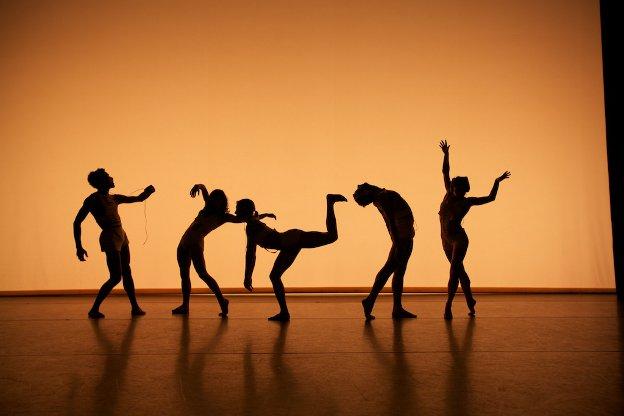From the moment we arrive at the Arnolfini and are asked to remove our shoes and put on white socks, there is a kinetic sense of anticipation in the air, the audience bunching nervously towards the entrance of the auditorium. Darkness envelops us, and the space into which we must step is fenced by shoulder-height LED tubing on all sides. Sam Collins’ lighting design is captivating, riffing on a smoldering palate of nightclub neon and UV with occasional white bliss and black calm; there is a sense of danger to the space that really emerges from the minimalist charm of his design. Collins proves he is not afraid to work with darkness, as well, and provides the perfect accompaniment for Glyn Perrin’s techno/electronica soundscape.
We have arrived in Fleur Darkin’s DisGo: an alternative, yet familiar space that sees the audience on stage, in amongst the dancers. DisGo’s premise is to ask the question, What do you think of when you are on the dance-floor? And it is this premise that makes the work a cause for celebration and concern: a dance floor should set you free, but questioning what you’re doing in each moment hampers the very release that the simplest of actions could or should bring. This concerning stimulus is justified and bravely integrated into the work, however.
There is something terribly engaging about watching able and expert dancers perform tightly choreographed sequences, and it is these moments that take hold in the mix and thrust of the action. Left dangerously motionless in awe of their expertise, you are quickly swept back into the world as the principal cast hug, hold and lead you into their lives, where a loose story foregrounds other basic actions and provides the motivation for repetitive cycles that intermingle or take you into small groups. In moments of express freedom you find the rhythms of the environment taking hold of your own body, but it is when hitherto unknown members of the cast suddenly break into synced rhythms of action that you feel simultaneously excited by the spectacle and self-aware at your inadequacy in not knowing the sequence.
Order and chaos conflict with one another as they are deftly explored through personal awkwardness, moments of free improvisation, choreography and even the order and symmetry of the space through the grand marshaling of the audience. All are appropriate and personally experienced in the real world in any given environment, from the mosh pit of a night club to an awkward family wedding dance. Yet with all of that, I personally wanted more; I wanted to experience a sense of euphoria, the freedom and release of being with strangers and letting myself go. If DisGo can go further in order to replicate those moments of shared experience en masse as in De La Guarda orFuerzabruta this truly could be fantastic dance floor journey.


